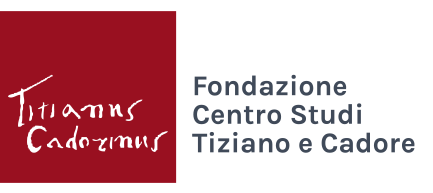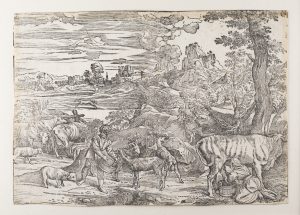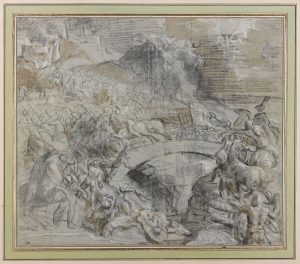Heritage
Titian library
From the time it was founded in 2003, the Fondazione Centro studi Tiziano e Cadore has promoted a series of important projects, contributing towards an increased knowledge of the artist and thus becoming a concrete cultural entity in Titian studies.
One of the projects consists of enriching the Titian Library, currently located in two places: the old part, established by the Celso Fabbro Foundation, is located in the Palazzo of the Magnifica Comunità di Cadore – which owns this part of the library – whereas the modern and contemporary part, composed of R.W. Rearick’s bequest and various acquisitions, is housed in Titian the Orator’s House.
This project is curated by the scientific committee, which is working so that in as short a time as possible this collection, which is composed of documents, manuscripts and volumes of historic value concerning Titian’s life and works, is made available to the public for its consultation.
Rare 16th-century writings, three different editions of Cesare Vecellio’s Habiti, as well as a manuscript on the Pieve di Cadore castle and the churches in Cadore, with exquisite illustrations by an anonymous author and artist, are part of the library collection.
Library Opening Hours:
Monday, Wednesday and Thursday 14:30-18:30
Tuesday and Friday 8:30 – 12:30
Curator: Raffaella Vallone
Library on-line
Consult the on-line library in the catalogue of the Belluno libraries, under catalogo delle biblioteche bellunesi /Servizio Bibliotecario Nazionale (OPAC SBN).
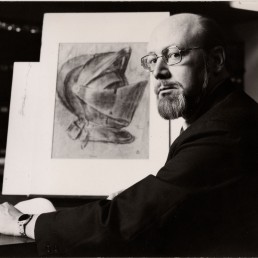
William R. Rearick
William R. Rearick (20.09.1930 to 31.07.2004), who was universally known as “Roger” was born in Carlisle, Pennsylvania, to a family of distant Scottish origin. His passion for the history of art emerged at a very early age. He studied as an undergraduate at New York University and obtained his doctorate from Harvard University. However, given his principal interest in Italian and, in particular, Venetian art, he spent great lengths of time in Italy, studying at the University of Padua with Giuseppe Fiocco and working on his PhD dissertation, a fundamental monographic study on Jacopo Bassano.After working at the Frick Collection in New York, he taught at John Hopkins University in Baltimore and the University of Maryland until 1991, the year in which he retired and moved definitively to Venice. In Venice he dedicated his time exclusively to his much-loved research on Venetian Renaissance art.As well as a dense series of studies dedicated to Jacopo Bassano and his sons, he made important contributions to the study of other great 16th-century Venetian artists, from Giorgione to Titian to Paolo Veronese. His extremely methodological approach became clear from the very outset of his career. It is an aspect which defines one of the greatest contributions to the history of Venetian art of the past decades, his work on the graphic production of the artists. This aspect of Venetian art had more or less been relegated to a specialist category until Rearick’s work. For him, however, it had always been a fundamental component of the creative process; an indispensable component in reconstructing the culture and personality of artists. The catalogue of the 1976 Florence exhibition, Tiziano e il disegno veneziano del suo tempo, the volumes on the Maestri veneti del Cinquecento published by Alinari (1977-1980) and the numerous articles and papers dedicated to the drawings of individual artists, from Jacopo Bassano to Lorenzo Lotto, from Paolo Veronese to Jacopo Tintoretto, are exemplary. A kind of summa of his research culminated in the 2001 volume titled Il disegno veneziano del Cinquecento, published in a more concise version than the author himself had initially wanted.Yet, a memoire on Roger Rearick cannot be limited only to his scholarly activities: friends, colleagues and students, who knew him, will never forget his extraordinary kindness, the affability with which he welcomed everyone to his Venetian home, and he generosity with which he shared his knowledge.
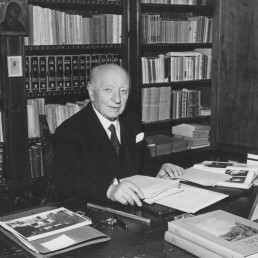
Celso Fabbro
Born on 23 January 1883 in Auronzo di Cadore, Celso Fabbro attended the University of Padua where he graduated in law with highest honours. Apart from his work as a lawyer, he found the space and time to hold important political positions and for more than fifty years he also dedicated himself to collecting news items, documents, books and etchings related to Titian.His studies on Titian resulted in a large number of writings published in various newspapers and magazines. He also published a book that still remains a primary reference for Titian studies: Tiziano: La vita e le opera, printed on the initiative of the Magnifica Comunità di Cadore for the first time in 1968 and subsequently reissued in other editions.It was Celso Fabbro himself, as President of the Magnifica Comunità di Cadore, who supported and brought to fulfilment the restoration of Titian’s house in Pieve di Cadore.Upon his death, in Jesi in 1974, his valuable Titian book collection was bought and housed by the Magnifica Comunità di Cadore itself. The patrimony created by the lawyer-scholar is made up of approximately 500 titles, a hundred or so of which date prior to 1830: six 16th-century writings, numerous first editions and other rare and important volumes on Titian published before the 1960s.
The Titian Print Collection
Beginning in 2013, The Foundation for the Study of Titian and Cadore has been compiling an extraordinary collection of Titian prints, some of which date back to Titian’s later years (the High Renaissance period) and some deriving from re-producing and copying. The collection comprises prints of exceptionally high quality and importance ranging from the sixteenth to the twentieth century, providing thus a meaningful sample of the ‘after Titian’ print culture, while also testifying to how widespread in terms of space and time were both the diffusion of Titian’s iconography and the collecting of his pictorial and graphic works.
Initially comprising 161 sheets, the collection has throughout the years been constantly expanded by the Foundation by means of targeted and well-planned purchases, until the Summers of 2020-21, when it was the recipient of two generous donations by co-founders of the Foundation, Luigina and Carmelo Paludetti. The donations amounted to more than 130 items, including works which have immense artistic value and are extremely rare, such as original woodcuts and large-size watercolour sheets.
This collection, jointly with the collection historically held by Cadore’s ‘Magnificent Community’ comprising 81 examples of the highest artistic quality, can be considered as the first in Italy for printmaking, placing it, at international level, as an innovative centre for collecting, conservation, valorisation and research in the field of printmaking and printmaking history, for the benefit of both scholars and enthusiasts and an ever expanding general public. Among the numerous high quality works held by the Foundation one should mention some fine woodcuts such as the celebrated Landscape with Milkmaid and Eagle attributed to Nicolò Boldrini from around 1530; the four watermarked sheets from the majestic Triumph of Christ in the Roman edition by Andrea Andreani, alongside the exquisite engravings by Cornelis Cort and Martino Rota, as well as some remarkable sheets from the seventeenth, eighteenth and nineteenth centuries; additionally, some illustrated series from among the most important European museum collections, culminating in impressive lithographic plates and engravings executed with special techniques, such as drypoint or mezzotint.
https://www.uace.eu/tiziano-vecellio/stampe/
Curator: Peter Lüdemann
The Photographic Collection
Photographic Programme of Titian’s oeuvre
The Photographic Archive of The Foundation for the Study of Titian and Cadore – credited by the Veneto Region for its ‘local interest’ – originated from the bequest of W.R. Rearick, who donated to the Foundation his personal photographic archive of Titian’s paintings and drawings, many of which are in private collections and therefore difficult to locate, making his gesture a particularly valuable one.
Subsequently, and especially since 2010, the archive has been enhanced thanks to individual purchases and photographic projects commissioned through a number of research programmes. The material is catalogued in the regional digital system as well as in the traditional (non-digital) database according to the norms of correct conservation.
Several factors contributed to convincing the Foundation that a photographic project on the work of the great Cadorino master was necessary: among them, the differing quality of extant photographic documentation, the presence of Titian’s works in virtually all corners of the world, and the arrival of the digital era offering so many new possibilities. The project’s aim was the creation of a virtual picture gallery of Titian’s work which would be unrivalled owing to its outstanding high definition image quality. Whenever possible, the same method was followed throughout as had inspired the photographic project devoted to documenting the works of art present in the Veneto Region: the same criteria applied, as if all works were seen by the same “eye”.
The programme was supported by the Regione Veneto. Its first project focused on drawings. In 2011 and 2012 the renowned Fratelli Alinari company photographed all of Titian’s drawings held at the Gabinetto Disegni e Stampe of the Uffizi Gallery, Florence, and at the Cabinets des Dessins in Paris (Louvre, École des Beaux Arts, and Institut Néerlandais). For each of the above mentioned drawings the Photographic Collection holds a 10 x 12 cm ektachrome slide, a 10 x 12 cm b/w negative, a high resolution digital file and a 20 x 24 cm b/w print.
The next step was the photographic project of Titian’s paintings starting with those held in Venice and the Veneto Region as a whole – in churches, museums and ‘Scuole’. The guiding principle was the possibility of investigating the quality deriving from a single photographer using the same technological parameters for the total body of work photographed. Our Photographic Collection is comprehensive and unique precisely because of this methodological criterion. The same consistent quality was adopted for Italian and foreign museums alike where a substantial core of Titian’s works is held – from the Louvre to the National Gallery of London and the Scottish National Gallery in Edinburgh, the Prado Museum in Madrid, the National Museum of Capodimonte in Naples, the Kunsthistorisches Museum in Vienna and the Rome museums (Galleria Borghese, Galleria Spada, and Pinacoteca Capitolina). For each photographic reproduction the Photographic Collection holds: a high resolution digital file, saved in Tiff and Jpeg (maximum quality) format, and a b/w 20 x 24 cm print.
Our aim is to be able to complete the process of gathering together the photographic reproduction of Titian’s paintings held throughout the world. Our wish is to become the primary reference point for the study of Titian through the visual reproduction of his works.
Finally, the Photographic Collection has digitised the drawings (20 pages) which are contained in an anonymous manuscript dating from the beginning of the nineteenth century, The Castle of Pieve and other Historical Memories of Cadore, which is part of its holdings. Furthermore, it holds 350 photographs documenting the collection of Titian prints – which may be consulted both on site and online https://www.uace.eu/tiziano-vecellio/stampe/archivio/.
All material pertaining to paintings and drawings which is the property of public institutions and museums was received with the proviso that it be consulted on site. For its use in publications, permission must be obtained from the owner and a copyright fee is requested.
Curator: Stefania Mason
